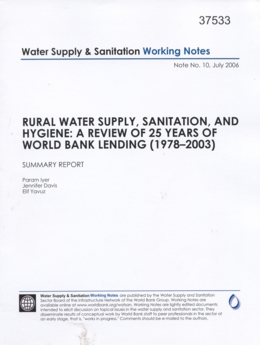 This summary review is drawn from a larger report, “Rural Water Supply, Sanitation, and Hygiene at the World Bank: A Review of 25 Years of Lending (1978-2003)” available at www. Worldbank.org/watsan.
The World Bank has more than 25 years of experience with lending for Rural Water Supply, Sanitation and Hygiene (RWSSH) projects. Since the first sector loan in 1978 through 2003, the World Bnak lent approximately US$ 5.5 billion for RWSSH investments, using both single-sector (or “dedicated” water and sanitation) and multisector lending instruments.
Whereas the World Bank has undertaken assessments of its RWSSH portfolio in the past, such reviews have been limited in their coverage regionally, temporally, or substantively. This review, which represents the only known effort to investigate the full universe of Bank-supported projects in the sector, was spurred in part by the Millenium Development Goal (MDG) initiative. Recognizing that improving access to water and sanitation services in rural areas can play a major role in the poverty reduction agenda embodied by the MDGs, the World Bank’s Energy and Water Department launched this review to provide the Sector Board with (a) an overview of historical trends, as well as the current scope and direction, of the RWSSH portfolio; (b) key insight regarding the alignment of the World Bank’s RWSSH activities with its commitment to attaining the MDGs; and (c) a proposed agenda to address gaps in knowledge and to help maximize the impact of the World Bank’s RWSSH lending. Table of Contents: 1. Introduction 2. Findings
2.1 Lending and the Millenium Development Goals (MDGs)
2.2 Stand-alone and multisector operations
2.3 Sustainability
2.4 Scalability
2.5 Sanitation and Hygiene 3. Conclusions
Post Date : 05 Juni 2009
|
